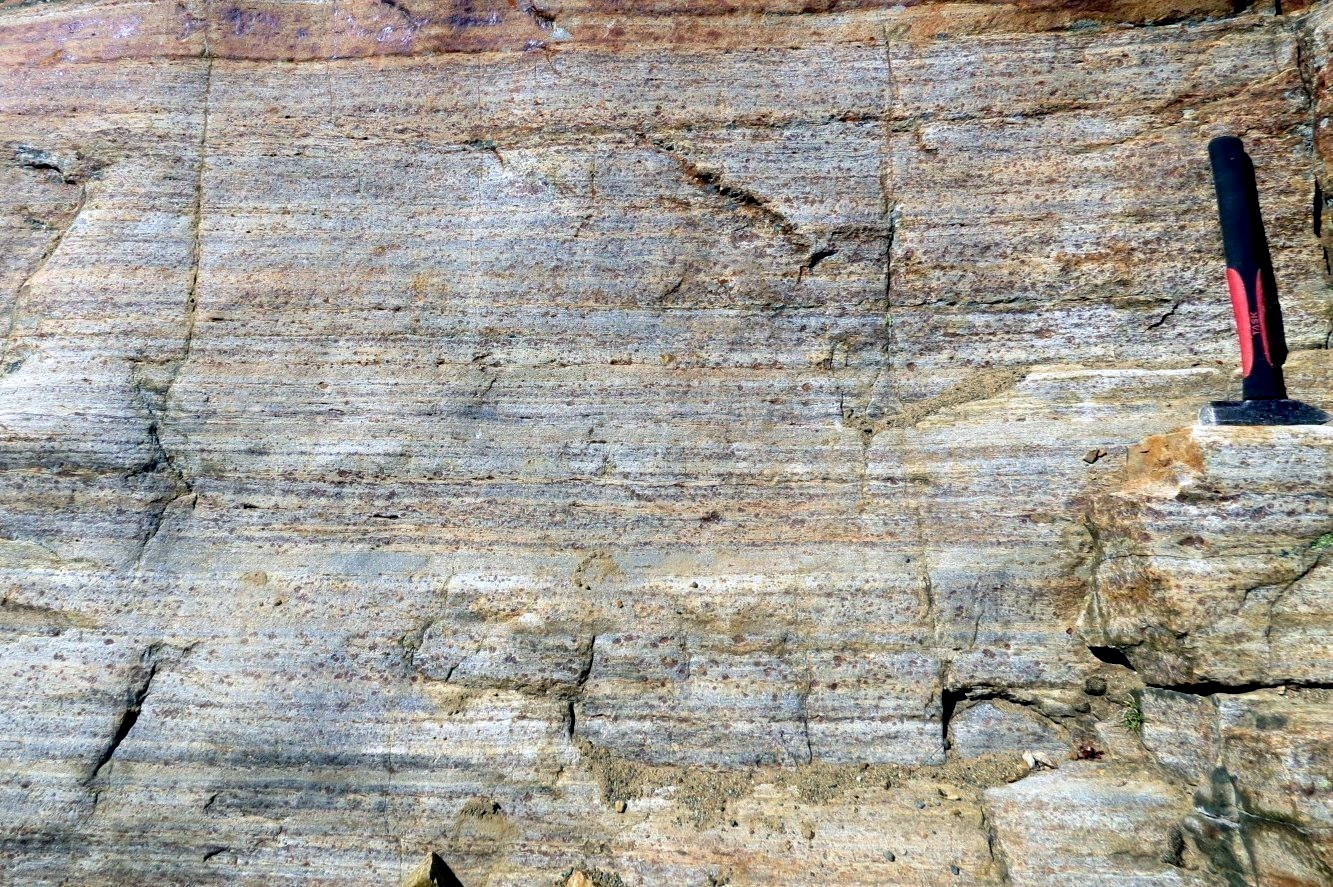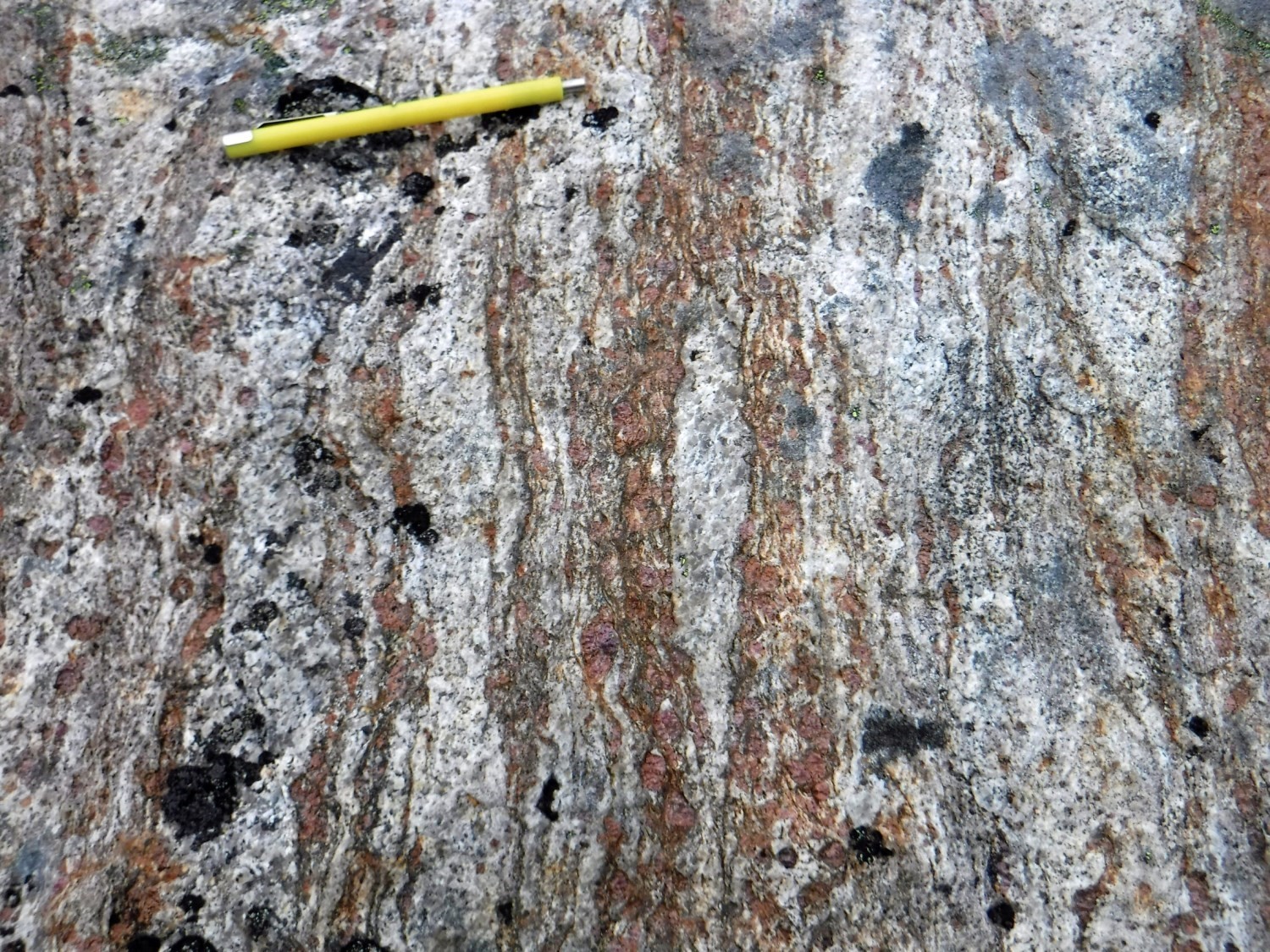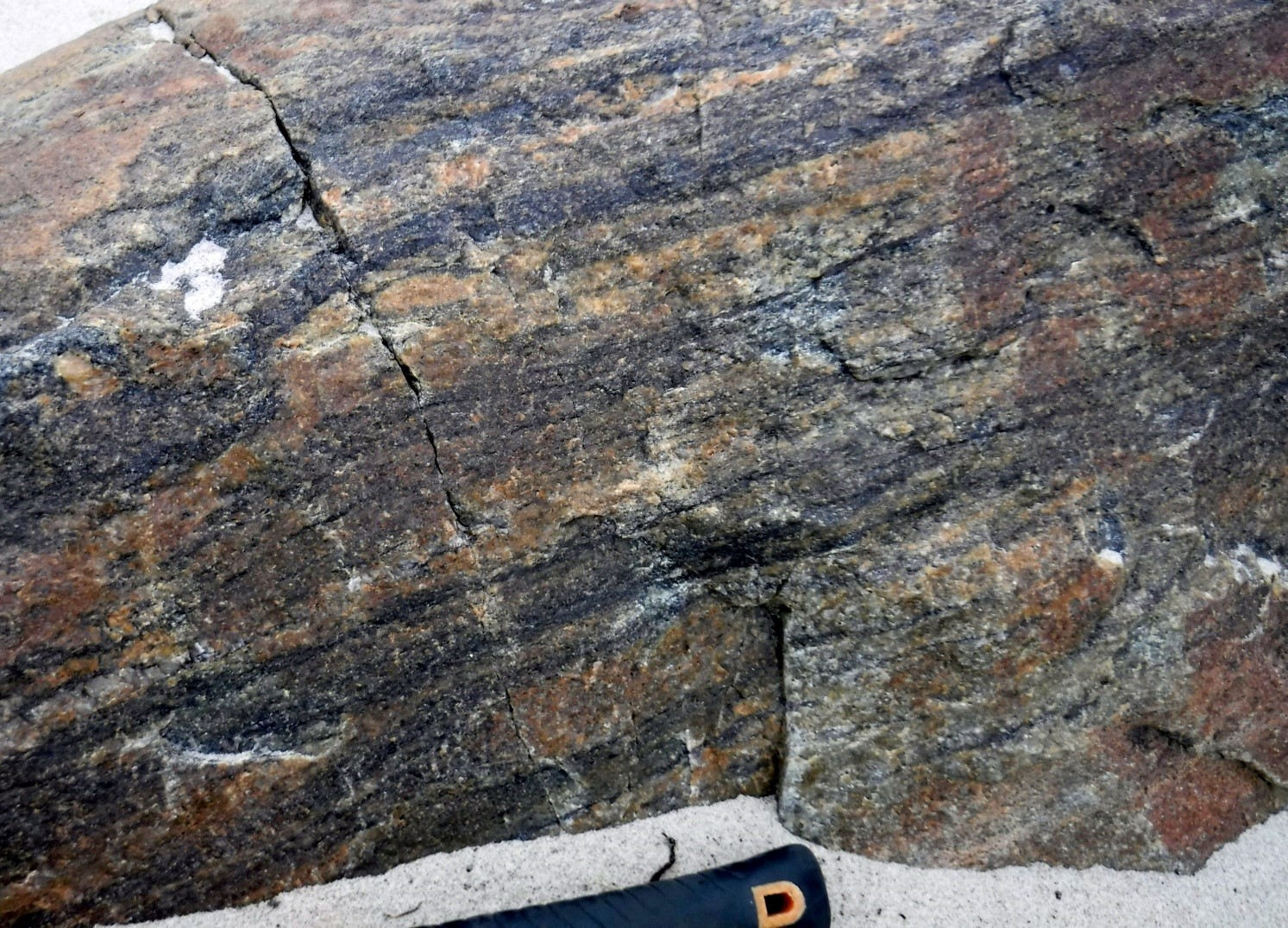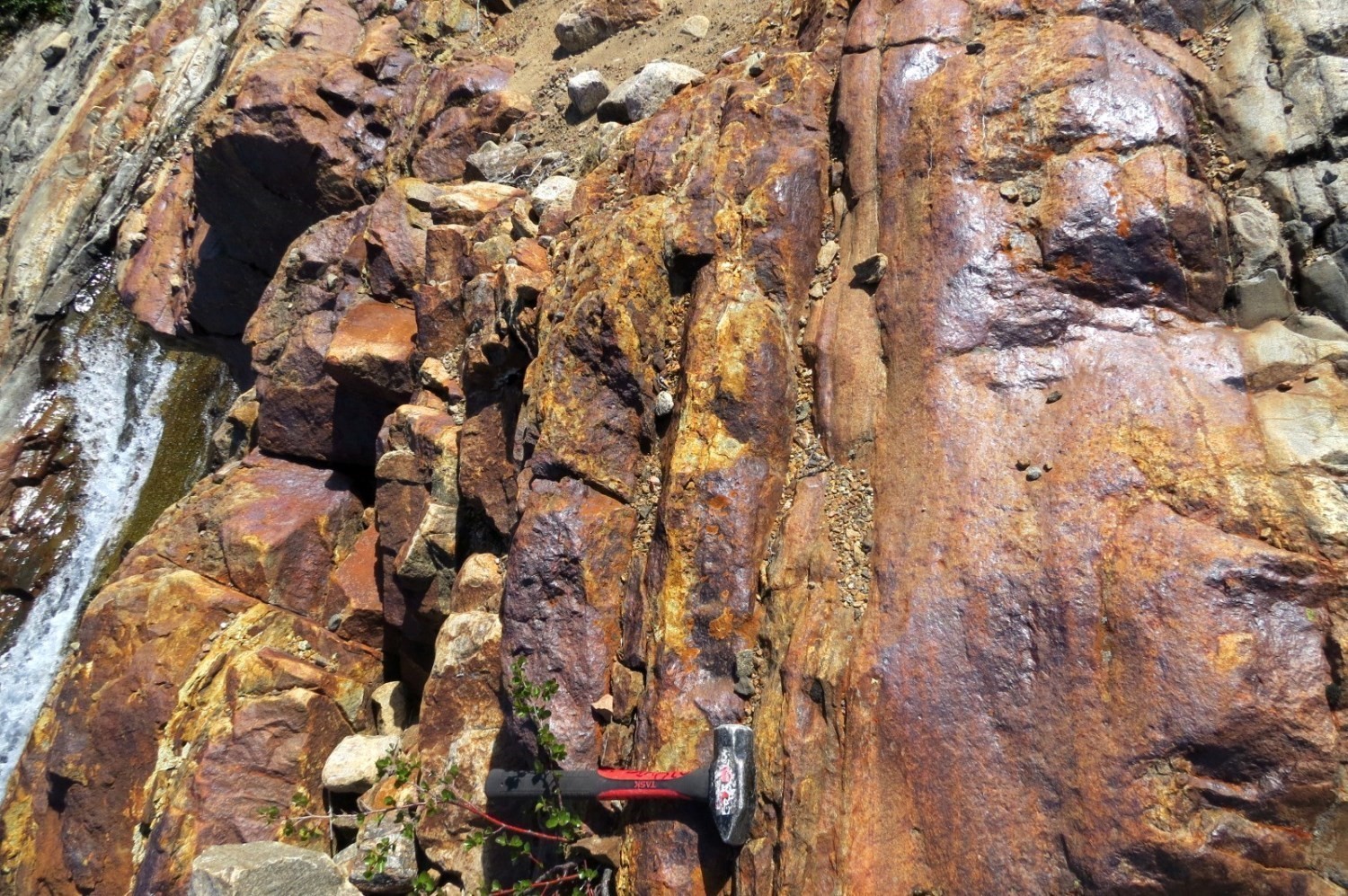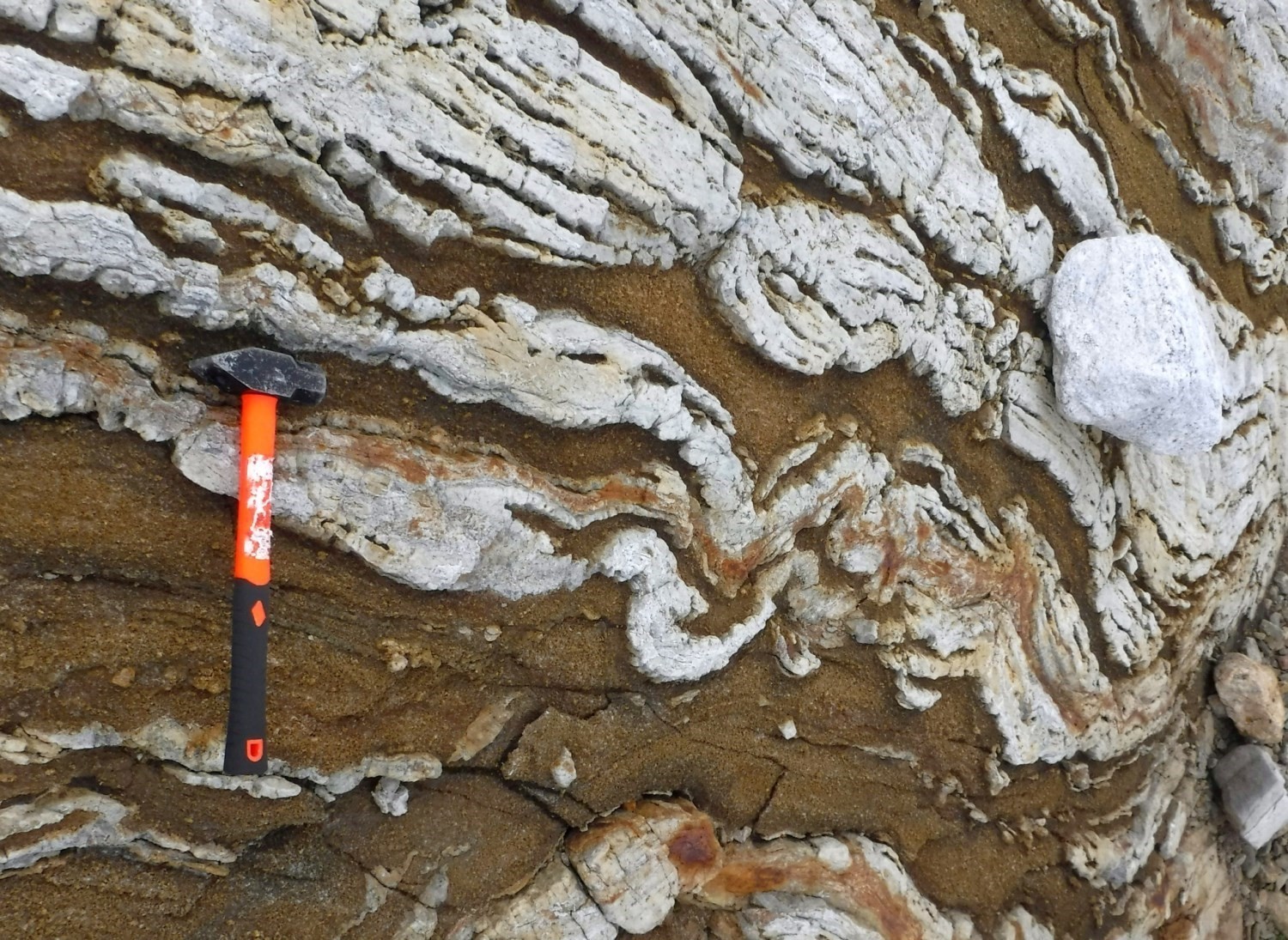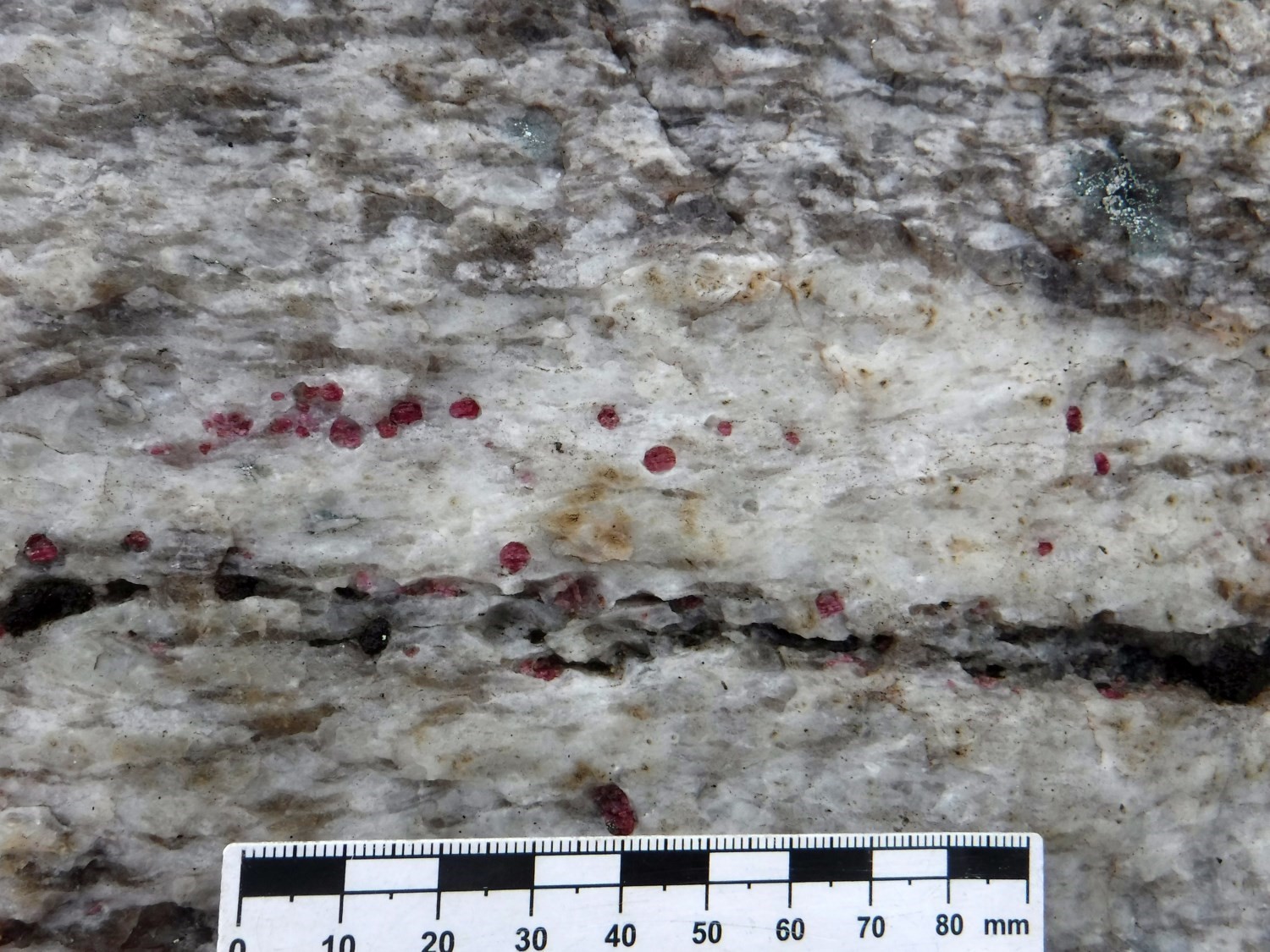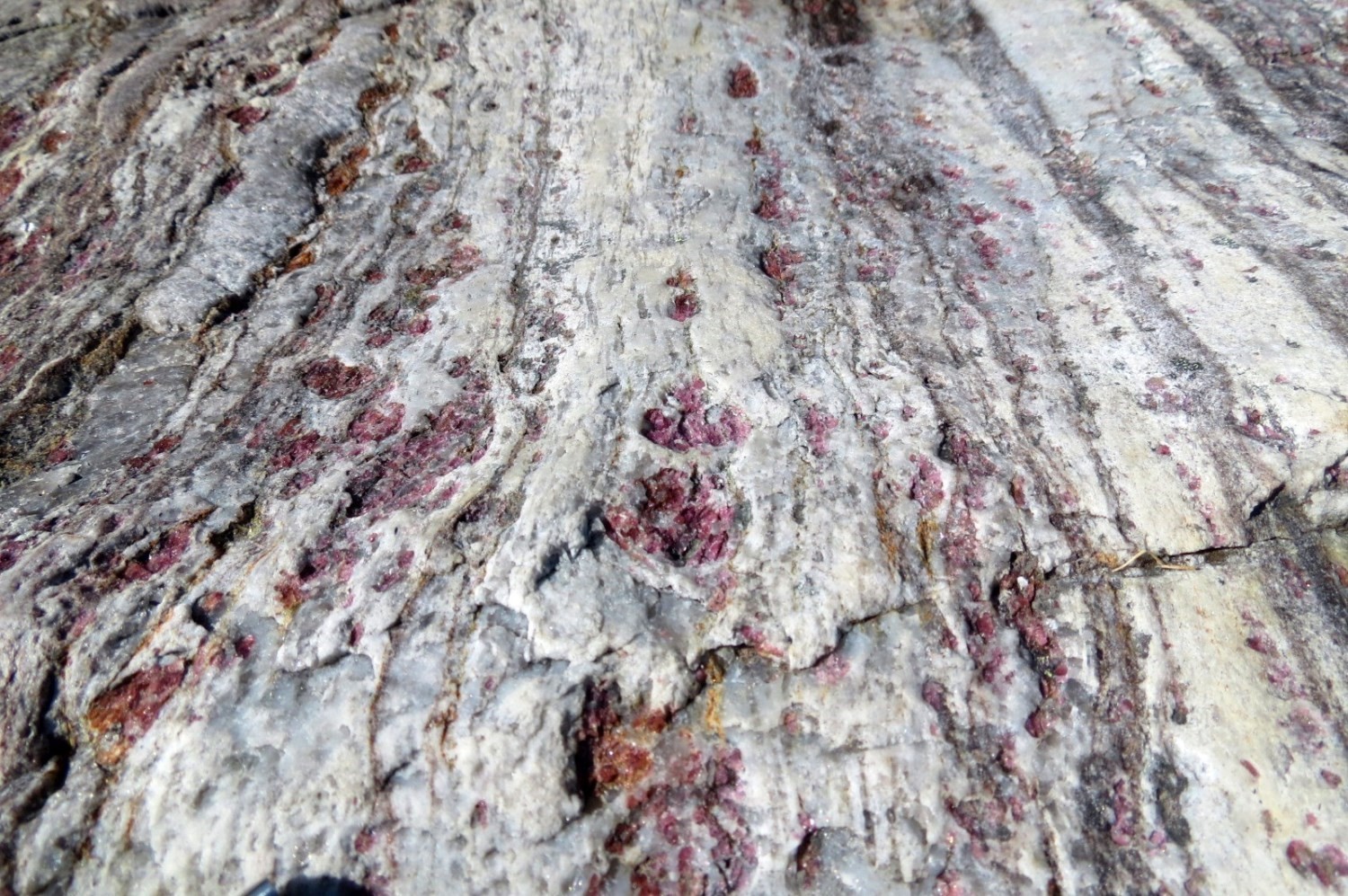
| Author: | Wardle, 1983 |
| Age: | Paleoproterozoic |
| Stratotype: | None |
| Type area: | Nachvak Fjord area, Labrador (NTS sheet 14M04) |
| Geological province: | Nain Province |
| Geological subdivision: | Burwell Lithotectonic Domain |
| Lithology: | Metamorphosed and migmatitized sedimentary rocks |
| Type: | Lithodemic |
| Rank: | Complex |
| Status: | Formal |
| Use: | Acive |
None
Background
Wardle (1983) designated the “Tasiuyak Gneiss” after a branch of the Nachvak Fjord of the same name, a band originally mapped by Taylor (1979) in the Saglek Fjord area of Labrador. This unit is initially described as a homogeneous protomylonitic quartzofeldspathic gneiss characterized by white patina and lilac garnet. In the ensuing years, geologists at the Geological Survey of Canada (GSC) conducted a regional mapping campaign covering the entire Torngat Mountains that helped to better identify Tasiuyak Gneiss (Van Kranendonk, 1993, 1994a, 1994b; Van Kranendonk et al., 1994a, 1994b, 1995; Van Kranendonk and Wardle, 1995). Verpaelst et al. (2000) mapped the Tasiuyak Gneiss in the Hebron area (NTS sheet 14L), at the foot of the Iberville Mountain, using Wardle’s terminology. The name “Tasiuyak Complex” was introduced by Mathieu et al. (2018) as a result of the Ministère’s 2017 regional mapping work in the Point Le Droit area (sheet 24P) to comply with the North American Stratigraphic Code.
Description
The Tasiuyak Complex consists of lithologies derived from sedimentary protoliths. The high metamorphic grade, partial melting and intensity of deformation complicate the distinction between paragneiss, metatexites and other diatexites. As early as 1983, Wardle was reluctant to quantify the degree of partial melting and to identify the exact composition of the protolith. However, he proposed as a protolith an immature sedimentary rock composed of layers of pelite and quartz arenite. Only the late facies of the complex is clearly identified as anatectic granite. The Tasiuyak Complex is predominantly composed of a paragneiss, metatexite and diatexite unit characterized by a very light beige patina, lilac garnet and a small proportion of hydrated phases such as biotite. The other metasedimentary units represent minor components that are commonly interstratified at the outcrop scale. The Tasiuyak Complex is subdivided into: 1) a unit of garnet-sillimanite-rutile paragneiss, metatexite and diatexite associated with minor amounts of biotite (pPtas1); 2) a quartzite unit (pPtas2); 3) a marble and calc-silicate rock unit (pPtas3); and 4) a white anatectic granite unit (pPtas4).
Rocks of the Tasiuyak Complex are characterized by a low to very low magnetic susceptibility, which makes them easily recognizable on aeromagnetic maps (GSC, 1985). Similarly, the distinctive light beige patina and rusty layers allow the unit to be followed on satellite images.
The mineral assemblages described in the Tasiuyak Complex samples are predominantly anhydrous (garnet-sillimanite-biotite-oligoclase-perthite-rutile-graphite). They are typical of the granulite facies. In addition, some layers contain orthopyroxene. Tettelaar and Indares (2007) studied in more detail the Paleoproterozoic regional metamorphism to the granulite facies of a metasedimentary band located in the southern part of the complex, west of the Nain community. This episode led to partial melting of metapelites. These authors propose a continuous biotite + sillimanite + plagioclase + quartz = garnet + K-feldspar + liquid reaction. The metamorphic peak conditions were about 8 to 10 kbars for a temperature of 870°C in this area.
Tasiuyak Complex 1 (pPtas1): Garnet-Rutile ± Sillimanite ± Biotite Paragneiss, Metatexite and Diatexite
The dominant unit pPtas1 consists of a rock with very light beige patina, commonly yellowish, and a bright white fresh surface. It shows compositional and granulometric banding of centimetric to decimetric scale. Bands are heterogeneous, very fine (recrystallization) to medium grained. The major mineral phases are milky quartz (20-75%), K-feldspar (1-30%), usually microcline but also orthose and perthites, and white plagioclase (5-60%). The plagioclase composition was optically determined by Ermanovics and Van Kranendonk (1998) at An25-37 (oligoclase). Mafic or aluminous minerals (5-40%) are represented by garnet (10-25%), sillimanite and red biotite (<5%). Accessory phases are graphite, sulphide, rutile, zircon and apatite.
Garnet has a typical lilac colour. It occurs as rounded poikiloblastic crystals (up to 5 cm in diameter) with rotational textures, which suggests syntectonic crystallization. A second generation of subhedral crystals has inclusions and is therefore interpreted as late-tectonic. These two habits commonly observed in the same outcrop imply that the growth of garnet continued after the deformation episode. Garnet is rich in quartz and sillimanite inclusions. Its composition is almandine-pyrope with a Mg proportion decreasing from the core to the grain edge (Ermanovics and Van Kranendonk, 1998).
Sillimanite is nematoblastic. Rods are oriented parallel to foliation and follow the contour of garnets, which suggests pre-kinematic growth, but have a random orientation in the foliation plane. Rutile occurs as small, elongated prisms, but also as sphene pseudomorph, from which it preserves the wedge-shaped habit. Mafic minerals are concentrated in thinner bands that could be considered relics of more refractory material. They are found in smaller quantities in coarser quartzofeldspathic bands interpreted as mobilisate.
Nebulatic, stromatic and, more scarcely, mesh migmatitic textures are reported, but the intensity of the deformation makes it difficult to recognize these different facies.
Some authors (e.g., Van Kranendonk et al., 1994a) interpret the compositional banding as remnants of primary bedding transposed to an immature sediment. They report the presence of millimetric to metric bands of paragneiss derived from quartz arenite, semi-pelite and pelite. The chemical composition of these rocks reaches 26% Al2O3 (Ermanovics and Van Kranendonk, 1998).
Most of the Tasiuyak Complex is affected by the Abloviak Shear Zone (ASZ) and has protomylonitic texture. Quartz with undulatory extinction forms rods or lenses stretched due to dynamic recrystallization. Both potassium and plagioclase feldspars have undulatory extinction and curved twins. Microstructures associated with deformation such as mortar structure and grain edge migration are observed everywhere in thin section. In the western area, which is the most deformed, poikiloblastic garnets are associated with recrystallization tails.
Bands of mafic to ultramafic rocks with garnet and spinel have been reported by several authors (Verpaelst et al., 2000; Ermanovics and Van Kranendonk, 1998). These bands are not mapped to the work scale as their apparent width is <10 m. Their mineralogical composition includes garnet, orthopyroxene, clinopyroxene, hornblende, plagioclase, hercynite, oxides and quartz inclusions in garnet. These rocks are granoblastic; garnet and pyroxene are poikiloblastic.
Ermanovics and Van Kranendonk (1998) also report the presence of low silica paragneiss with sapphirine and orthopyroxene in the south of the Tasiuyak Complex.
The main pPtas1 unit incorporates four subunits: 1) an orthopyroxene-garnet-rutile ± sillimanite ± biotite paragneiss, metatexite and diatexite subunit (pPtas1a); 2) a rusty paragneiss subunit (pPtas1b); 3) a subunit of biotite-garnet paragneiss, metatexite and diatxite poor in sillimanite (pPtas1c); and 4) a cordierite-garnet-rutile ± sillimanite ± biotite paragneiss, metatexite and diatxite subunit (pPtas1d).
Tasiuyak Complex 1a (pPtas1a): Orthopyroxene-Garnet-Rutile ± Sillimanite ± Biotite Paragneiss, Metatexite and Diatexite
Subunit pPtas1a shows the same characteristics, both petrographic and petrological, as the main unit, except for the presence of orthopyroxene visible in thin section in the paleosome or as a peritectic phase in the mobilisate. Hypersthene is subhedral, corroded and regularly shows partial replacement by iddingsite. Locally, the subunit has a brown sugar colour characteristic of orthopyroxene rocks, but this is not always the case. This subunit is weakly magnetic.
Tasiuyak Complex 1b (pPtas1b): Rusty Paragneiss
Rusty paragneiss with graphite and disseminated sulphides (pPtas1b) was first described by Van Kranendonk (1994a, b). This subunit has the same petrological and petrographic characteristics as the main pPtas1 unit. The main differences are finer grain size, with quartz, plagioclase and K-feldspar grains smaller than one millimetre, and garnet rarity (<2%). Graphite occurs as millimetric flakes that commonly form clusters aligned in foliation in association with red biotite flakes. Analyses indicate a δ13C isotopic ratio of -34.37‰, which suggests a biogenic origin for carbon (Bodycomb, 1994). Bodycomb proposes that these layers come from metamorphism of black shales. Pyrrhotite is fine, subhedral and disseminated. Lesser amounts of sphalerite, pyrite, magnetite and gahnite are also reported by this author. The proportions of graphite and sulphides vary from a few percent to 40% (semi-massive mineralization). The rusty bands are easily located due to the colour contrast with the paragneiss characterized by a dominant beige patina. These units are variable in size and form lenses or metric boudins up to kilometric bands a few metres to a few tens of metres wide. Layers of pPtas1b are usually boudinaged and include 2 cm to 2 m thick quartzite bands. This subunit is slightly magnetic.
Tasiuyak Complex 1c (pPtas1c): Biotite-Garnet Paragneiss, Metatexite and Diatexite Poor in Sillimanite
Subunit pPtas1c is characterized by the absence of sillimanite and relative abundance of red biotite (Van Kranendok, 1994b). Its patina is beige grey, darker than the main unit, and it outcrops mostly along the eastern and northern edges of the complex, close to contact with the Killinek Suite. It has the same characteristics as the dominant unit, but incorporates homogeneous metric horizons rich in biotite and fine-grained garnet.
Tasiuyak Complex 1d (pPtas1d): Cordierite-Garnet-Rutile ± Sillimanite ± Biotite Paragneiss, Metatexite and Diatexite
This unit outcrops occasionally. It shows all the characteristics of the main unit, the difference being the presence of retrograde cordierite. Cordierite is the result of pseudomorphic replacement of sillimanite. Locally, it forms perfectly crystallized crystals. It was also observed as inclusion in garnet. The presence of cordierite is accompanied by a second generation of garnet that forms symplectites with quartz. Cordierite is partially replaced by pinite.
Tasiuyak Complex 2 (pPtas2): Quartzite
The unit pPtas2 quartzite is described by Van Kranendonk (1994b) as a fine-grained grey rock with graphite and garnet. Metric layers of siliceous paragneiss and quartzite were also mapped in 2017 in the Point Le Droit area (Mathieu et al., 2018). They are interbedded with the main pPtas1 unit and are rarely mapped to the work scale. The biggest layers are 400 m thick. The patina is very light brown to grey and the fresh surface is whitish. Rocks are characterized by medium grain size and centimetric compositional banding defined by variations in the proportion of quartz (70-90%). Late lilac garnet (<10%) is fine grained (1-2 mm) and evenly distributed in the rock. It locally forms porphyroblasts up to 5 mm in diameter. Quartz forms rods or stretched lenses with undulatory and subgrain extinction. Quarzite also contains plagioclase and potassium feldspars finely recrystallized, graphite flakes and rutile prisms.
Tasiuyak Complex 3 (pPtas3): Marble and Calc-silicate Rocks
Van Kranendonk et al. (1993) report the existence of thin layers of marble and calc-silicate rocks (<15 m thick) interstratified with metasedimentary rocks of the main pPtas1 unit. These authors describe impure diopside-olivine-calcite marble interbedded with light-green diopside calc-silicate layers 1 -10 m thick, cut locally by many conformable or unconformable white quartz veins.
White marble in fresh exposure has a buff-coloured patina. It is coarse grained, banded and contains more than 40% calc-silicate bands in positive relief. Calc-silicate layers in the Point Le Droit area (Mathieu et al., 2018) are finely to moderately recrystallized, light green in fresh exposure with a grey-green to very light brown patina. They consist of a heterogeneous assemblage of diopside, orthopyroxene, plagioclase replaced in places by scapolite, quartz and phlogopite (up to 10%). Accessory phases are actinolite, sphene, olivine and interstitial carbonates.
Tasiuyak Complex 4 (pPtas4): White Garnet Granite
This unit was introduced to designate the most evolved lithological variety in terms of partial melting. It consists mainly of alkali feldspar granite and syenogranite, which form discontinuous and diffuse metric clusters in metatexite outcrops (pPtas1), but also larger masses up to 1-3 km in diameter. The patina is very light beige. Granite is generally homogeneous with little textural variation such as banding observed locally. It also contains enclaves and layers of paragneiss and metatexite in sharp contact. On the other hand, it shows diffuse contact with diatexite. Granite is characterized by coarse-grained perthitic microcline. Fine to medium-grained quartz is interstitial and forms anhedral crystal clusters with undulatory extinction. Myrmekites develop along the edges of plagioclase crystals (10%). Mafic and aluminous minerals do not exceed 10% of the mode. They are represented by garnet, biotite and sillimanite. Accessory phases are graphite, epidote, zircon and opaque minerals.
Tasiuyak Complex 4a (pPtas4a): White Garnet-Cordierite Granite
This subunit shows a slightly yellow alteration patina and a bluish light grey fresh surface. Blue cordierite crystals are clearly visible in the samples. In thin section, cordierite is partially replaced by pinite.
Tasiuyak Complex 4b (pPtas4b): White Garnet Tonalite
Subunit pPtas4b consists of a coarse-grained, homogeneous, white tonalite poor in mafic minerals (<5%). It is impossible in the field to differentiate it from the granite facies. Mafic minerals are garnet, biotite and cordierite. Plagioclase is weakly sericitized and shows twins slightly bent by deformation.
Thickness and Distribution
The Tasiuyak Complex features a 400 km-long, NNW-oriented flared band that stretches from western Saglek Fjord in Labrador, curves to the NW in the Jacques Rousseau Mountain area to reach the Abloviak Fjord in Quebec. The complex also outcrops on Baffin Island. Its width exceeds 60 km in its southern part and is reduced to 15 km in its northern part. Klippes a few decametres to a few kilometres long by a few metres to a few hectometres wide are incorporated into gneiss of the Noodleook Complex (Anoo) and intrusions of the Killinek Suite (pPkil).
Dating
Godet et al. (2021) obtained ages between 3013 and 1937 Ma for detrital zircons with main modes between 2.1 and 1.9 Ga. The ages obtained on garnet and monazite, around 1885 Ma and 1873 Ma respectively, are interpreted as representing prograde metamorphism (subsolidus). The metamorphic age of 1848 Ma is interpreted as representing the mean retrograde age (Godet et al., 2021).
Bertrand et al. (1993) dated zircons from a sample described as a garnet-biotite anatectic granite syntectonic to the Tasiuyak Complex (pPtas4). The age obtained around 1844 Ma also corresponds to the age of formation of the Abloviak Shear Zone. The sample also provided inherited ages between 1886 and 2087 Ma.
Scott and Gauthier (1996) obtained ages ranging from 1940 ±2 to 1895 ±2 Ma for detrital zircons from a Tasiuyak Complex metasedimentary rock sampled in northern Labrador. The age of the youngest zircon obtained for this sample (1895 Ma) is the maximum age of sediment deposition. A sample of orthopyroxene quartz diorite from the Killinek Suite (pPkil4) cutting paragneiss was dated 1895 Ma by Scott (1995). The ages of detrital zircons below 2.1 Ga imply that the Tasiuyak cannot be the result of erosion of Archean rocks of the Nain Province, since they are too old, nor those of the younger Churchill Province.
On Baffin Island, a metamorphic age of 1852 Ma was obtained for zircon overgrowths in a garnet-sillimanite metatexite sample (Scott and Gauthier, 1996). Also on Baffin Island, Scott et al. (2002) obtained ages between 2.35 and 1.83 Ga for detrital zircons, with main modes at 2.02 Ga and 1.89-1.87 Ga along with well-defined secondary modes at 2.34 Ga and 2.23 Ga.
| Unit |
Sample Number |
Isotopic System | Mineral | Maximum Age of Deposition (Ma) |
Detrital Age (Ma) |
Crystallization Age (Ma) | (+) | (-) | Metamorphic Age (Ma) |
(+) |
(-) |
Reference(s) |
| pPtas1 |
2017-IL-3148A |
U-Pb | Zircon | 1937 | 3013 to 1937 | 1838 | 12 | 12 | Godet et al., 2021 |
|||
| Monazite | 1873 | 5 | 5 | |||||||||
| Lu-Hf | Garnet | 1885 | 12 | 12 | ||||||||
| D338C | U-Pb | Zircon | 1916 | 2350 to 1830 | Scott et al., 2002 | |||||||
| D338B | U-Pb | Zircon | 1852 | 2 | 2 | Scott and Gauthier, 1996 |
||||||
| D80A | U-Pb | Zircon | 1940 | 2062 to 1940 | 1870 | 3 | 3 | |||||
| pPtas4 | ES89-G1 | U-Pb | Zircon | 1843.9 | 3.6 | 3.6 | Bertrand et al., 1993 |
Stratigraphic Relationship(s)
Metasedimentary rocks of the Tasiuyak Complex show transposed contact with intrusions of the Killinek Suite (pPkil) and gneiss of the Noodleook Complex (ApPnoo). In this very heavily deformed area, it is not possible to define the nature of these contacts. Nevertheless, a crosscutting relationship of paragneiss (pPtas1) by orthopyroxene quartz diorite (pPkil4) is observed in places (Scott, 1995). Very locally, white garnet granite (pPtas4) intrudes into Killinek orthopyroxene quartz diorite (pPkil2), suggesting that partial melting occurred after the Killinek Suite was emplaced.
Paleontology
Does not apply.
References
Publications Available Through SIGÉOM Examine
MATHIEU, G., LAFRANCE, I., VANIER, M.-A., 2018. Géologie de la région de pointe Le Droit, Province de Nain et sud-est de la Province de Churchill, Nunavik, Québec, Canada. MERN; BG 2018-07, 4 plans.
VERPAELST, P., BRISEBOIS, D., PERREAULT, S., SHARMA, K. N. M., DAVID, J., 2000. Géologie de la région de la rivière Koroc et d’une partie de la région de Hébron, 24I et 14L. MRN; RG 99-08, 62 pages, 10 plans.
Other Publications
BERTRAND, J.M., RODDICK, J.C., VAN KRANENDONK, M.J., ERMANOVICS, I. 1993. U-Pb geochronology of deformation and metamorphism across a central transect of the Early Proterozoic Torngat Orogen, North River map area, Labrador. Canadian Journal of Earth Sciences; volume 30, pages 1470-1489. https://doi.org/10.1139/e93-127
BODYCOMB, V. 1994. Characterization and metallogeny of base metal, graphite, and tungsten showings, paleoproterozoic Torngat orogen, eastern Ungava Bay, Québec. Université du Québec à Montréal; Master’s thesis, 173 pages.
COMMISSION GÉOLOGIQUE DU CANADA (CGC), 1985. Magnetic anomaly map, Torngat Mountains, Newfoundland and Quebec / Carte des anomalies magnétiques, Monts Torngat, Terre-Neuve et Québec. Commission géologique du Canada; Cartes des anomalies magnétiques NO-20-M, 1 plan. https://doi.org/10.4095/120288
ERMANOVICS, I., VAN KRANENDONK, M.J. 1998. Geology of the Archean Nain Province and Paleoproterozoic Torngat Orogen in a trasect of the North River-Nutak map areas, Newfoundland (Labrador) and Quebec. Geological Survey of Canada; Bulletin 497, 156 pages, 7 plans. https://doi.org/10.4095/209574
SCOTT, D.J. 1995. U-Pb geochronology of a Paleoproterozoic continental magmatic arc on the western margin of the Archean Nain craton, northern Labrador, Canada. Canadian Journal of Earth Sciences; volume 32, pages 1870-1882. https://doi.org/10.1139/e95-144
SCOTT, D.J, GAUTHIER, G. 1996. Comparison of TIMS (U-Pb) and laser ablation microprobe ICP-MS (Pb) techniques for age determination of detrital zircons from Paleoproterozoic metasedimentary rocks from northeastern Laurentia, Canada, with tectonic implications. Chemical Geology; volume 131, pages 127-142. https://doi.org/10.1016/0009-2541(96)00030-7
TAYLOR, F.C. 1979. Reconnaissance geology of a part of the Precambrian Shield, northeastern Quebec, northern Labrador and northwest Territories. Geological Survey of Canada; Memoir 393, 99 pages, 19 plans. https://doi.org/10.4095/124930
TETTELAAR, T., INDARES, I. 2007. Granulite-facies regional and contact metamorphism of the Tasiuyak paragneiss, northern Labrador: textural evolution and interpretation. Canadian Journal of Earth Sciences; volume 44, pages 1413-1437. https://doi.org/10.1139/e07-029
VAN KRANENDONK, M.J. 1993. Geology, Mont Jacques-Rousseau, Québec-Newfoundland (Labrador). Geological Survey of Canada; Open File 2738, 1 plan. https://doi.org/10.4095/183959
VAN KRANENDONK, M.J. 1994a. Geology, Tower Mountain, Newfoundland (Labrador)-Québec. Geological Survey of Canada; Open File 2828, 1 plan. https://doi.org/10.4095/194136
VAN KRANENDONK, M.J. 1994b. Geology, Rivière Lepers, Québec-Northwest Territories. Geological Survey of Canada; Open File 2829, 1 plan. https://doi.org/10.4095/194055
VAN KRANENDONK, M.J., GODIN, L., MENGEL, F., SCOTT, D., WARDLE, R.J., CAMPBELL, L.M., BRIDGWATER, D. 1993. Geology and structural development of the Archean to Paleoproterozoic Burwell Domain, northern Torngat Orogen, Labrador and Québec. In: Current Research, Part C. Geological Survey of Canada; Paper 93-1C, pages 329-340. https://doi.org/10.4095/134260
VAN KRANENDONK, M.J., WARDLE, R.J. 1995. Geology, Lac Baret, Québec-Newfoundland (Labrador). Geological Survey of Canada; Open File 2985, 1 plan. https://doi.org/10.4095/203612
VAN KRANENDONK, M.J., WARDLE, R.J., MENGEL, F.C., CAMPBELL, L.M., GODIN, L., SCOTT, D.J., CHURCHILL, R., SCHWARZ, S., REID, L., RYAN, B., BRIDGWATER, D., HAUMANN, A., PATEY, R. 1995. Geology of the Archean Nain Province and Paleoproterozoic Torngat Orogen, Newfoundland (Labrador) – Quebec – Northwest Territories. Geological Survey of Canada; Open File 2927, 4 plans. https://doi.org/10.4095/203612
VAN KRANENDONK, M.J., WARDLE, R.J., MENGEL, F.C., CAMPBELL, L.M., REID, L. 1994. New results and summary of the Archean and Paleoproterozoic geology of the Burwell domain, northern Torngat Orogen, Labrador, Quebec, and Northwest Territories. In: Currect Research, part C. Geological Survey of Canada; Paper 1994-C, pages 321-332. https://doi.org/10.4095/193840
VAN KRANENDONK, M.J., WARDLE, R.J., MENGEL, F.C., CHURCHILL, R., CAMPBELL, L.M., SCHWARTZ, S. 1994. Geology, Lac de Lorière, Newfoundland (Labrador)-Québec. Geological Survey of Canada; Open file 2925, 1 plan. https://doi.org/10.4095/194833
WARDLE, R.J. 1983. Nain-Churchill Province cross-section, Nachvak Fiord, northern Labrador. In: Current Research, Newfoundland Department of Mines and Energy, Mineral Development Division; Report 83-1, pages 68-89. https://www.gov.nl.ca/iet/files/mines-geoscience-publications-currentresearch-1983-wardle-cr1983.pdf
Suggested Citation
Ministère des Ressources naturelles et des Forêts (MRNF). Tasiuyak Complex. Quebec Structural Lexicon. https://gq.mines.gouv.qc.ca/lexique-stratigraphique/province-de-nain/complexe-de-tasiuyak_en/ [accessed on Day Month Year].
Contributors
|
First publication |
Guillaume Mathieu, Eng. Geo., M.Sc. guillaume.mathieu@mrnf.gouv.qc.ca (redaction) Mehdi A. Guemache, P. Geo., Ph.D. (coordination); Claude Dion, Eng. Geo., M.Sc. (critical review); Simon Auclair, P. Geo., M.Sc. (editing); Céline Dupuis, P. Geo., Ph.D. (Englsih version); André Tremblay and Nathalie Bouchard (HTML editing). |


